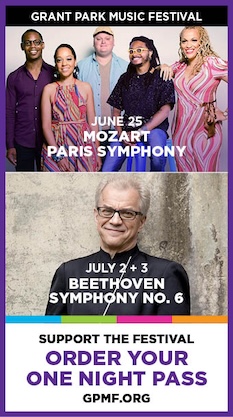Emerson Quartet and guests offer a stellar evening centered on 20th-century music

In a concert for the memory books, the Emerson Quartet and guests delivered superb performances of three very different early 20th Century masterworks Wednesday evening at Symphony Center.
Janacek’s Second Quartet Intimate Letters (1928), Berg’s Lyric Suite (1925) and Schoenberg’s Verklarte Nacht (1899) all share an inner core of passionate romanticism that unites them at the deepest level while their musical language is strikingly divergent.
The concert opened with the Janacek, and the quartet, all standing except for the cellist, projected the unconventional formal structure of this highly personal work with authority. The lead throughout is taken by the viola (Janacek quixotically intended to use the viola d’amore as a reflection of his unconventional romantic attachment to a far younger woman but found the instrument lacked the necessary dynamics). Violist Lawrence Dutton here and in the other pieces on the program fulfilled the demanding technical requirements of the piece starting with the unearthly bridgework at the opening and continuing throughout many exposed sections of romantic declaration.
The Romantic feeling predominates in a dance-like opening to the third movement, projecting a happiness that is squelched by some fierce emotional tumult and upper string intensity and a brusque ending. The last movement begins with a Slavonic dance and although lacking the last ounce of Slavic soul the Emerson negotiated their way through many mood shifts and impossibly complex and dynamic sections culminating in a bravura finale to this, Janacek’s last completed work.
The Lyric Suite by Alban Berg is another work inspired by a forbidden attachment. Yet here the musical vocabulary is informed by numerological elements as well as the 12-tone technique recently systematized by Schoenberg, so the romantic emotion is constrained by more technical requirements. Berg, here as so often, somehow seems to transcend the serial mechanism with feeling and sonic beauty so the work can be heard as a delicately scored quartet which the Emerson brought off immaculately.
After the straightforward sonic experiments of the first two movements the Allegro misterioso third movement is especially appealing and the Emerson captured the opening shimmer and playful tremolos, pizzicatos and ponticellos surrounding a broader Trio estatico which expands on the romantic narrative.
The intense fourth movement Adagio appassionato is notable for its deeper tonality and cellist David Finckel (who is departing the group after this season) was a standout individually and as a solid anchor underpinning the slow unwinding of the contemplative closing.
In this performance the original setting of Stefan George’s German translation of Baudelaire’s De Profundis was sung by mezzo-soprano Julia Bentley and she communicated the poem’s passion with a vocal richness contrasting nicely with the more austere strings. This work should be performed with the vocal part more often, especially if a singer of the quality of the evening’s artist is available.
As for the Schoenberg Transfigured Night, the sextet version heard in this performance (with guests violist Paul Neubauer and cellist Colin Carr) is of a piece with both the preceding works in its emotional core and technical demands. The Emerson members had no problem with the mechanics and the emotions were expressed by the individual and collective unfolding of the highly romantic and passionate themes which seem to refer to Wagner, Debussy and even Brahms in the richness of the scoring.
The piece was inspired by a late 19th-century poem written by Richard Dehmel which depicts two lovers on a walk together into a new understanding. After many romantic detours there is a moment of silence toward the end which represents the turning point in the conversation and what follows is the transfiguration implied in the work’s title.
The performance by the sextet was remarkably cohesive. They played this sensual music as one and nailed every difficulty they encountered. If there was any weakness in their interpretation to these ears it was that the overall trajectory of the work was sacrificed to the attention paid to events on the journey.
The audience was thinner than usual for such stellar performers possibly because of the modernist repertoire. Too bad, as this sort of program crosses the gap gracefully between the traditional and the experimental and opens ones ears to a whole new repertoire that speaks directly to the deepest feelings.
Posted in Performances

